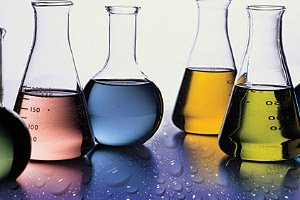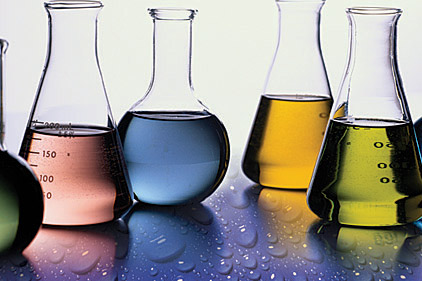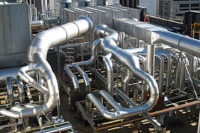
|
Iowa State University’s (ISU) new Hach Hall is an exception. Opened in the fall of 2010, the $52 million research facility incorporates numerous features to reduce its environmental footprint including rainwater capture, separation of laboratory spaces from classrooms, and the use of a fogging system for humidification, rather than a traditional boiler.
“It is a complicated building by its very nature and consumes a lot of resources,” says Mark Stephenson, ISU’s construction manager for facilities planning and management. The building received LEED® Gold certification, “something which is hard to do on a chemistry building or a laboratory.”
SEALING THE ENVELOPE
Starting out as Iowa Agricultural College and Model Farm in 1858, the college now enrolls 28,000 students from more than 100 countries, hosts a Department of Energy research laboratory, and has one of the ten largest undergraduate engineering programs in the country.
Iowa State’s Department of Chemistry serves more than 4,000 students each semester, and its graduate program in analytical chemistry is ranked among the top 20 in the country by U.S. News and World Report.
ISU’s 259,000-sq-ft Gilman Hall has housed the Chemistry Department since 1916. But to meet expanding needs, the university decided to build a second chemistry building, Hach Hall, just north of Gilman Hall. The 136,000-sq-ft structure, designed by OPN Architects of Cedar Rapids, IA, in collaboration with laboratory design consultants Ellenzweig (Cambridge, MA) has three floors above ground and one below, along with a mechanical penthouse that holds the air handling and other equipment. The ground floor hosts the main public functions including teaching laboratories and pre-lab classrooms. The two higher floors contain research laboratories and faculty offices, while vibration and light sensitive research laboratories are in the basement.
As with other new buildings on campus, ISU was interested in energy efficiency. Its College of Design already had King Pavilion, the first higher education building in the state to receive LEED Platinum certification.
One key factor for Hach Hall was ensuring that the building envelope was well sealed.
“The construction manager on the job brought in someone to analyze those envelope details,” says Stephenson. “The contractors worked well together, and the details that usually are problematic were resolved.”
They put this to the test during the construction, once the exterior wall and window systems were in place and the crews commenced work on the interior details. Stephenson says that based on calculations, they installed three temporary heaters to maintain the temperatures in the building. But through the winter, they never needed to run more than one of the heaters.
“The building is well insulated and extremely tight,” he says. “There was very little air infiltration, which is a credit to the people who provided the building envelope.”
CONTROLLING THE TEMPERATURE
Designers desired similar efficiencies for the permanent heating. Laboratories are contained in one section, with the offices, conference rooms, and lobby all on the west side of the building. This allowed one set of HVAC systems for the laboratories containing chemical fumes and another set for those the spaces where human health and comfort were the primary considerations. The laboratories, in addition to the normal room ventilation systems, have more than 260 fume ventilation hoods.
“The air system is primarily for ventilation, not heating or cooling,” says Matt Jesson, project manager for Waldinger Corp, which installed the AHUs. “If they were only dealing with the thermal load, there would be much less air going through there, but because of the exhaust, they have to use 100% outside air.”
Henneman Engineering’s Iowa City office designed the air-handling system. A single custom Phoenix Manufacturing, Inc.(PMI) air handler provides the heating and cooling to the lobby, conference rooms and other spaces on the west side of Hach Hall. The laboratory portion of the building is divided into four quadrants — northeast, northwest, southeast, and southwest. A separate 60,000-cfm PMI air handler is used for each of the quadrants. In order to reduce energy usage, each of these four AHUs included a plate heat exchanger to recover heat from the laboratory air before it was exhausted from the building. By using heat exchangers that were more efficient than ASHRAE minimum standards, together with zone presence sensors and VAV systems on the fume hoods, Henneman Engineering projected that the air-handling system would use about half the energy of a base code-compliant laboratory building.
The four AHUs that service the laboratories include reheat coils and operate around the clock throughout the year. The heating and cooling are controlled by thermostats that modulate dampers in a mixing box for the zone. Taking an example of where the room thermostat is set at 68°F, when the AHU is in cooling mode and the room temperature is above 68°, the return air thermostat controls the air handler supply temperature by modulating it between 57° and 65°. If the return air temperature is 79°, the supply air will be 57°; if the return air is 74°, the supply air will be 65°. In heating mode, again assuming a 68° setting, the air handler supply air temperature will be 65° and the room thermostat will turn on the reheat coil to maintain 68° in the room.
AHU5, which services the offices, uses a mixed air system rather than 100% outside air and operates similarly in the cooling mode. Since there are no reheat coils, however, the supply air is set at 85° and the flow modulated by the return air thermostat. Normal operating hours are 7 a.m. to 7 p.m. Monday through Friday. During the off hours, the system will maintain the room temperature so it doesn’t go below 65° or above 80°.
MAINTAINING MOISTURE
Because the laboratories use 100% outside air, it greatly increases the amount of humidification needed during the cold months.
“In the winter in Iowa, bringing in the cold air and heating it up you end up with very dry air,” says Jesson. “The humidity in the building would be 5% without the humidification.”
To achieve a design relative humidity of 30%, the humidification system needs to operate about 3,500 hrs/yr. Not all of this is at full capacity; the full load humidifier’s hours per year were calculated at 1,767. For the 200 hrs/yr the ambient temperatures were below zero, 4,600 to 4,800 lbs water/hr are required for the four main AHUs. As outside temperatures rose, the need for humidity gradually drops until, at 45°, the humidity load is only 740 lbs/hr. To provide the humidity in the most efficient manner, ISU decided to use a high-pressure fogging system.
“The user required a percentage of relative humidity, and our research indicated fogging was the most effective way,” says Stephenson.
To provide 4,800 pounds of steam per hour, a gas boiler system would need 6,792 MBtuh (thousands of Btuh). For the 1,767 full load hours required per year, this would translate to an estimated 13,677,004 MBtuh/yr, including flushing and distribution losses. At $1 per 100 cu ft (CCF) this would cost $136,770 per year. A high-pressure fogging system from Mee Industries Inc. (Irwindale, CA) sized to produce 4,800 lbs of humidity/hr, would use 10 kW, or 17,670 kWh/yr. At an electricity price of $0.065/kWh, the total price would be a projected $1,149/yr. However, because the fogging system would lower the air temperature, requiring additional heat input, the total cost comes to $106,703/yr, or about $30,000 less in energy costs than using a gas boiler.
Stephenson says that one other factor that led to selecting a fogging humidification system was that the chemistry building already had a system for producing deionized water.
“Producing clean water is one of the key pieces of producing a trouble-free humidifier,” he says. “Because the science lab already had that system in place, we were able to double use it, cutting the cost.”
KEEPING COMFORTABLE
ISU installed a single Mee high-pressure fogging system to service all five air handlers. The system uses two 5-hp CAT Pumps model FM-700-B1051P triplex (three piston) pumps with ceramic plungers, each producing 7 gpm at 1,000 psi, together with Baldor Electric Company motors with VFDs, CAT pumps Prrrrr-O-Lator pulsation dampeners, Rockwell Automation Allen-Bradley SLC 500 programmable controllers, and Danfoss A/S Nessie VDHT 2/2 way solenoid valves. For redundancy, there is an additional pump in case one of the two primary units goes down or is being serviced.
The fogging system, like the rest of the HVAC system, is tied into the campus’s Johnson Controls Metasys BAS. Depending on the need for humidity in one of the quadrants, the appropriate number of solenoid valves open up, allowing the water to flow through a series of 0.75- and 0.50-in. stainless steel pipes to the nozzle arrays in the air handler. Each of the arrays consists of nine 0.50-in. lines with a total of 94 fogging nozzles.
“We had a fairly limited space in terms of fitting the humidifiers into the AHUs,” says Jesson. “There was just enough room between the heating coils and cooling coils to insert these humidifiers.”
The two active pumps work in conjunction to serve all five air handlers and a zone panel at each AHU provides the ability to vary the capacity at each air handler. Initially, one of the pumps will operate, and then as the demand grows, the second pump kicks in.
“Both pumps are on a variable-frequency drive, so it doesn’t take very long for the second pump to kick in, then they will both operate at a lower speed just to maintain the 1,000 psi in the line,” says Don Stanek, president of Millennium Technology, Mee’s local representative who helped Henneman Engineering write out the project. “Then as you have more nozzles open up, and more humidity delivered to the air handler, the line pressure drops, so the VFD picks up speed on the pumps in parallel and provides more water flow to maintain 1,000 psi.”
Construction on Hach Hall was completed in 2010, and the building was dedicated in October. Stephenson says that he has been in the laboratories with the ventilation hoods running and is satisfied with the way the air handling system works.
“It’s actually quite comfortable,” says Stephenson. “It works well.”ES



